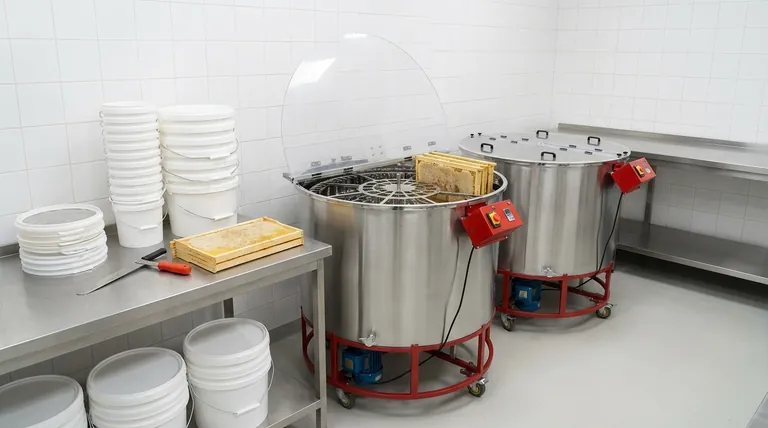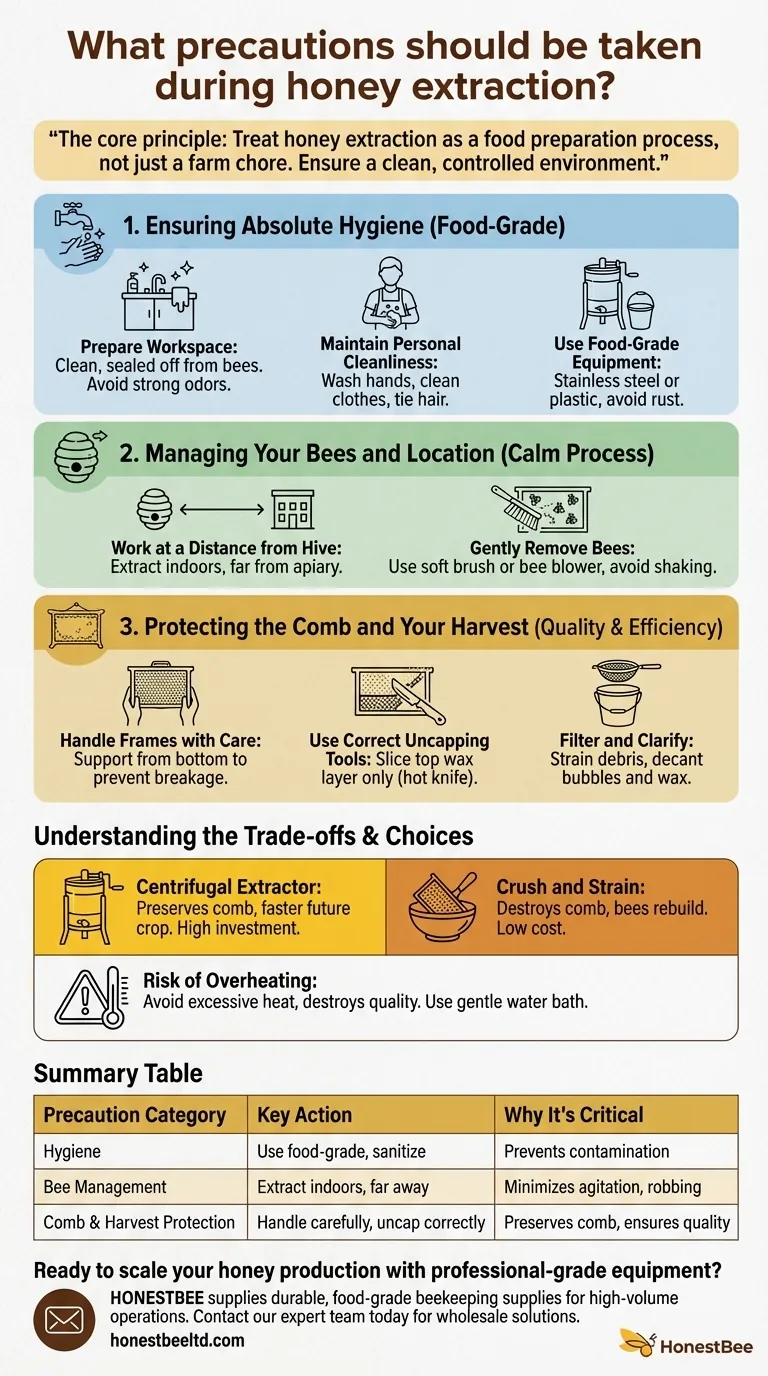The most critical precautions for honey extraction fall into three main categories: ensuring food-grade hygiene, managing bee behavior to prevent agitation, and handling combs and equipment carefully to protect your harvest. Failing to address any one of these areas can lead to contaminated honey, a defensive colony, or a damaged, less valuable product.
The core principle of a successful honey extraction is treating it as a food preparation process, not just a farm chore. Your goal is to create a clean, controlled environment that is separate from the hive to ensure safety, hygiene, and the highest quality honey.

Foundational Precaution: Ensuring Absolute Hygiene
Honey is a food product. The single most important precaution is to prevent any form of contamination during the extraction process. This begins before you even touch the first frame.
Prepare Your Workspace
Your extraction area must be meticulously clean and, critically, sealed off from bees. A kitchen or a dedicated, screened room is ideal.
Ensure all surfaces, equipment, and containers are washed and sanitized. Honey is hygroscopic, meaning it absorbs moisture and odors from the air, so avoid any space with strong smells.
Maintain Personal Cleanliness
Treat this process as if you were working in a professional kitchen. Wash your hands thoroughly, tie back long hair, and wear clean clothes.
Refrain from smoking or any activity that could introduce foreign particles or flavors into the honey. Cleanliness is a non-negotiable step to guarantee a safe and pure product.
Use Food-Grade Equipment
All equipment that comes into contact with the honey must be food-grade. This typically means stainless steel or food-grade plastic.
Avoid using equipment that could rust or leach chemicals. Tools like a stainless steel extractor, bottling pail with a proper gate, and clean filters are essential investments for protecting honey quality.
Managing Your Bees and Location
A calm extraction process begins with how you interact with the colony. The goal is to minimize stress on both the bees and the beekeeper.
Work at a Distance from the Hive
This is a crucial safety precaution. The smell of open honey and comb can quickly attract and agitate bees, leading to robbing behavior or defensive stinging.
Always perform the extraction in an indoor, bee-proof location, far away from the apiary. Bring the frames to the extraction space, not the other way around.
Gently Remove Bees from Frames
Before bringing frames indoors, you must clear them of bees. Use a soft bee brush or a bee blower to gently persuade the bees off the comb.
Avoid aggressive shaking or jarring, which can damage the comb and agitate the colony. The gentler you are, the calmer the bees will remain.
Protecting the Comb and Your Harvest
The physical integrity of your honeycomb directly impacts the efficiency of your extraction and the future health of your hive.
Handle Frames with Care
Honey-filled frames are heavy and can be fragile. Support them from the bottom to prevent the comb from breaking away from the frame, especially if it is not fully attached.
A broken comb is difficult to manage in an extractor and results in a loss of the bees' valuable work.
Use the Correct Uncapping Tools
The wax cappings on each cell must be removed. Use a dedicated uncapping tool like a hot knife, a cold serrated knife, or an uncapping scratcher.
The precaution here is to slice off only the top layer of wax. Cutting too deep into the comb damages the cell structure, making it harder for bees to repair and reuse.
Filter and Clarify the Honey
After extraction, honey will contain small particles of wax, pollen, and other debris. It is essential to strain the honey through a series of filters or strainers.
Allowing the honey to sit in a bottling tank or clarifier for a day or two (decanting) is a final precautionary step. This lets fine air bubbles and remaining wax particles rise to the surface, where they can be skimmed off before bottling.
Understanding the Trade-offs
The method you choose for extraction involves significant trade-offs between cost, effort, and the preservation of your equipment.
Extractor vs. Crush and Strain
Using a centrifugal extractor is the most efficient method and has the major advantage of preserving the drawn-out comb. Returning intact comb to the bees saves them an enormous amount of energy, leading to a faster next honey crop. However, extractors represent a significant financial investment.
The crush and strain method is inexpensive and requires minimal special equipment. However, it completely destroys the honeycomb, forcing the bees to rebuild it from scratch. This is a viable precaution against high startup costs for a hobbyist but is inefficient for a growing operation.
The Risk of Overheating
If you use a hot knife for uncapping or warm your honey to make it flow better, be extremely cautious. Overheating honey can destroy its beneficial enzymes and delicate aromas, fundamentally altering its quality. A gentle water bath is the safest method for warming.
Making the Right Choice for Your Goal
Your approach to extraction should align with your beekeeping goals.
- If your primary focus is hobby-scale beekeeping (1-3 hives): The crush and strain method is a perfectly acceptable precaution against unnecessary expense, provided you maintain strict hygiene.
- If your primary focus is growing your apiary for production: Investing in a stainless steel extractor is essential for preserving your comb and maximizing your honey yield over time.
By treating honey extraction with the care of a food-handling process, you protect the bees, the harvest, and the final product.
Summary Table:
| Precaution Category | Key Action | Why It's Critical |
|---|---|---|
| Hygiene | Use food-grade equipment & sanitize workspace | Prevents contamination of honey, ensuring a safe, pure product. |
| Bee Management | Extract indoors, far from the hive | Minimizes bee agitation and prevents robbing behavior. |
| Comb & Harvest Protection | Handle frames carefully & use correct uncapping tools | Preserves comb integrity for efficient extraction and hive health. |
Ready to scale your honey production with professional-grade equipment?
For commercial apiaries and beekeeping equipment distributors, proper tools are not just a precaution—they are an investment in efficiency and product quality. HONESTBEE supplies durable, food-grade beekeeping supplies and equipment designed for high-volume, wholesale-focused operations.
Contact our expert team today to discuss how our wholesale solutions can help you maximize your harvest and protect your investment, season after season.
Visual Guide

Related Products
- HONESTBEE 72 Frame Industrial Electric Honey Extractor for Beekeeping
- 8-Frame Electric Self-Reversing Honey Extractor Spinner for Commercial Honey Extraction Equipment
- 40 Frame Commercial Electric Honey Extractor for Beekeeping
- Commercial Electric 12 Frame Honey Extractor Spinner Motorized Honey Extractor
- HONESTBEE 3-Frame Manual Acrylic Honey Extractor
People Also Ask
- How do automatic honey extractors function? Achieve High-Efficiency Honey Harvesting
- What are the advantages of automated honey extractors in terms of time efficiency? Boost Your Harvest Speed
- Can a manual extractor be upgraded to an electric one? Save Labor & Boost Efficiency
- Why is preserving honeycomb integrity important, and how do automated extractors help? Boost Hive Health & Honey Yields
- What are the advantages of automatic honey extractors? Scale Your Apiary with Unmatched Efficiency



















